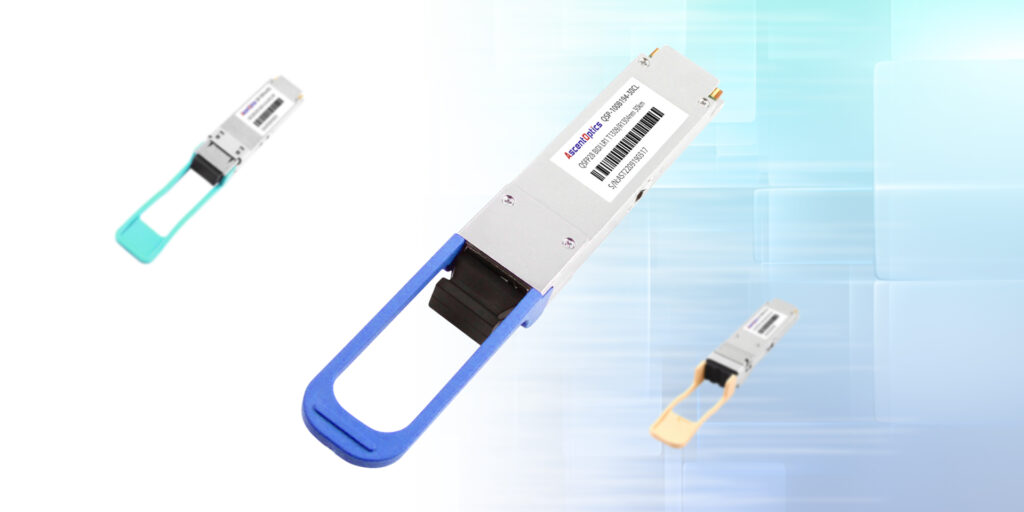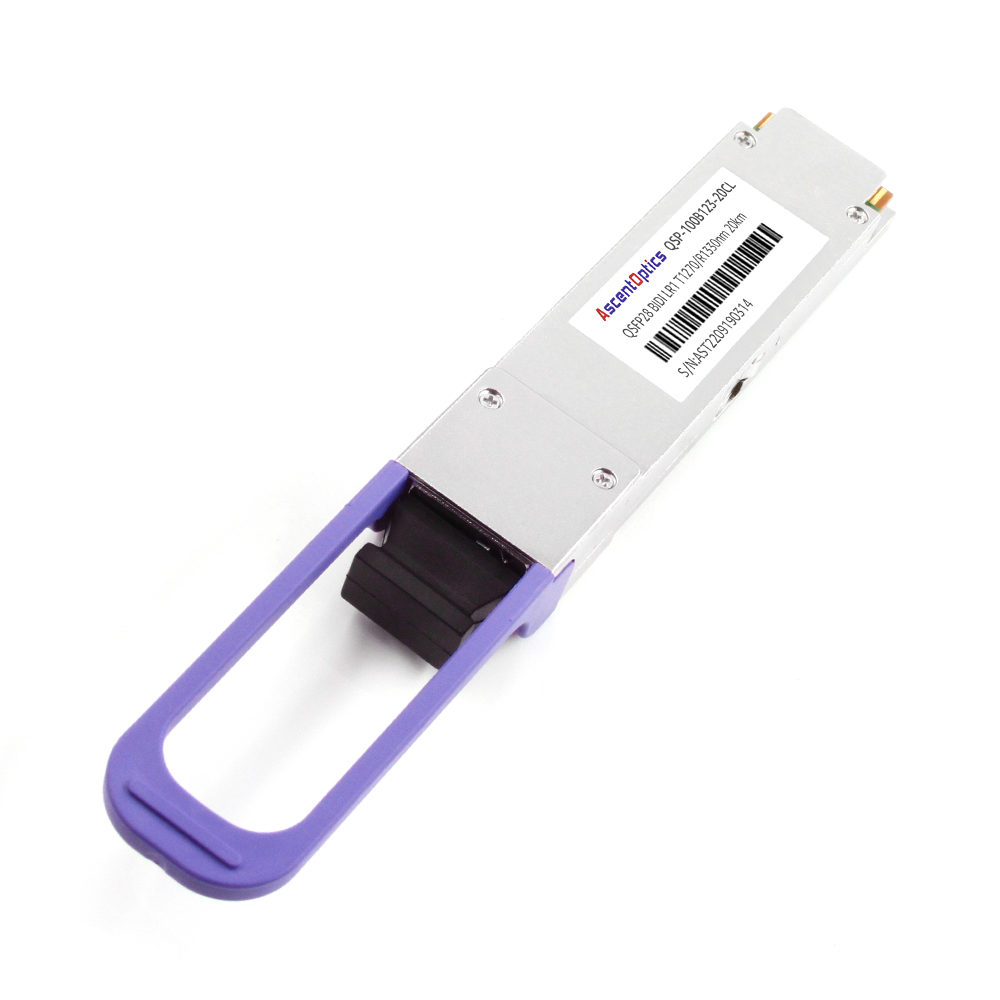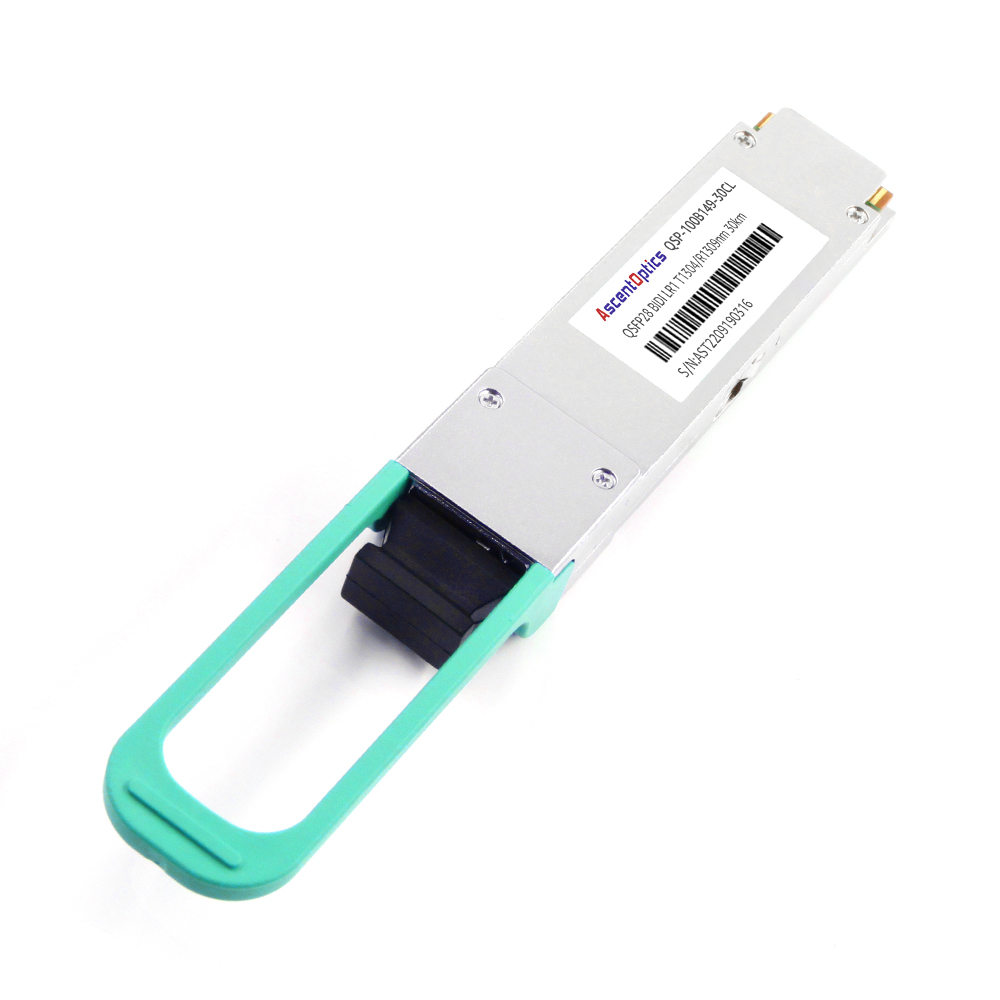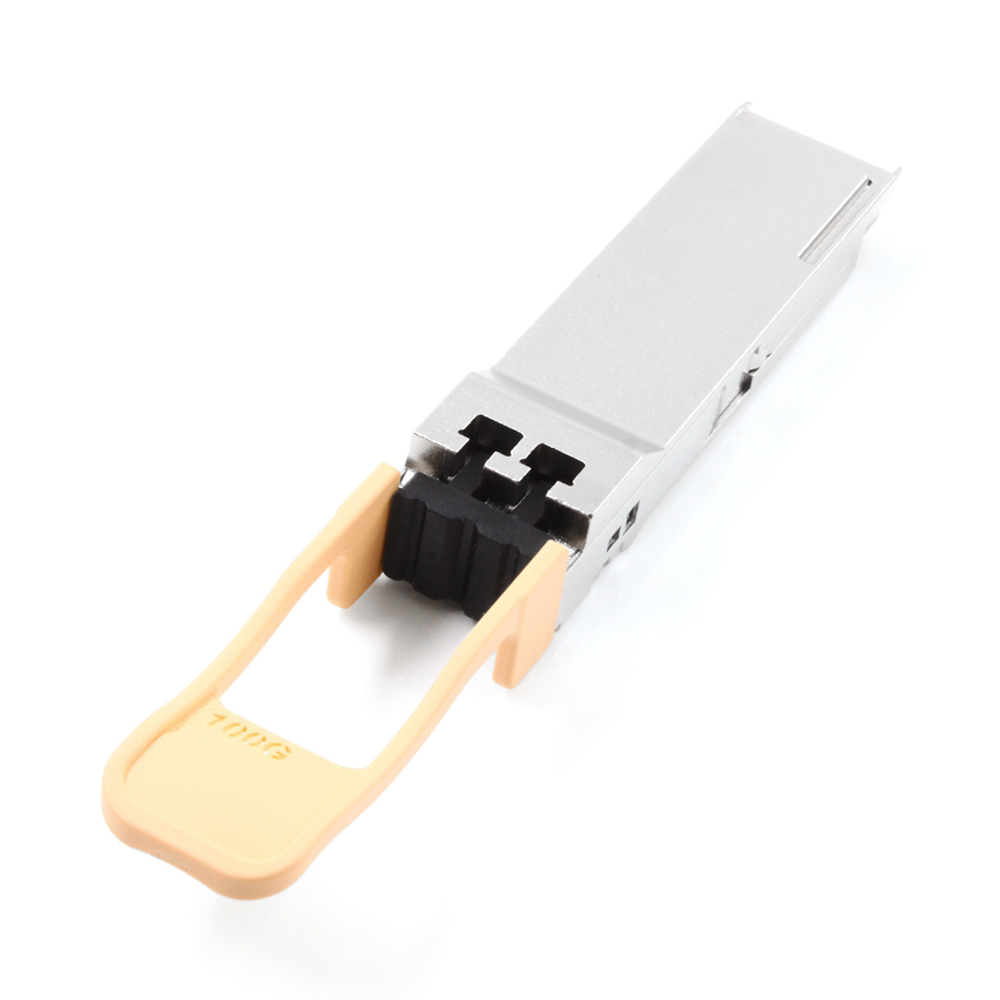
A 100G QSFP28 transceiver is an example of an optical transceiver that has a data rate set at 100 Gigabits per second (Gbps). QSFP28 is the acronym for Quad Small Form-factor Pluggable 28, which refers to the form factor of the transceiver module. This device is predominantly needed in data centers, high-performance computing networks, and other areas of interconnection where high-speed data transmission over fiber optics is a necessity.
Additionally, it helps with protocols such as Ethernet, Fibre Channel, InfiniBand, SONET/SDH and others. The 100G QSFP28 transceiver’s optical mode differs based on the requirements of the network, which may include short-reach, long-reach, or even extended-reach applications.
In conclusion, use of QSFP28 transceivers helps to achieve faster data transmissions, can work with different protocols and two or more types and distances of fibers, among other things. Different types of QSFP28 transceivers, namely SR4, LR4, and PSM4, have distinct other technical parameters and scopes of their functionalities to satisfy other network requirements. It is essential to know the characteristics of each variant in order to choose the appropriate transceiver for the intended task.

In this section, we will cover 100G QSFP28 transceivers and their types available for market, along with their details to help you understand their encompassing features and advantages.
The 100G QSFP28 SR4 transceiver is a multimode optical module that works on four lanes of OM4 or OM3 fibre with a link length of up to 100 meters. It employs a 4x25G electrical interface and is commonly found in high-performance computing environments for short-reach data transmission. The 100G QSFP28 SR4 transceiver is intended for short-reach applications, with a range of up to 100 meters on multimode fiber with parallel optics. It is used in data centers for switch-to-switch connectivities as well as server-to-switch applications. Four bidirectional lanes are able to transmit 25 Gigabits per second on each of the fiber pairs.
100G QSFP28 LR4 transceiver is a single-mode optical module that works on four fiber lanes with a link length of up to 10 kilometers. The 100G QSFP28 LR4 transceiver caters to long reach applications with a single mode fiber reach of up to 10 kilometers. It operates with four channels each transmitting at a rate of 25Gbps. It employs a 4x25G electrical interface which is widely used in telecommunications and data center applications for long-reach data transmission. It’s primarily deployed in telecoms, metro networks and data center interconnects.
The 100G QSFP28 PSM4 transceiver is a parallel single-mode optical module that works on four fibre lanes with a link length of up to 500 meters. It operates with four channels each transmitting at a rate of 25Gbps. It employs a 4x25G electrical interface and is suitable for intra-rack and inter-rack data center applications that necessitate higher density with lower power consumption.
The 100G QSFP28 PSM4 transceiver is intended for extended reach applications with a single mode fiber distance of up to 2 kilometers. It is widely used in long-haul telecoms networks which LR4 cannot cover due to the distance limitations.
The 100G QSFP28 ER4 transceiver is an extended-reach module that operates on single-mode optical fiber with a maximum link length of 40 kilometers over four fiber channels. It employs a 4x25G electrical interface and is primarily used in long-haul telecommunications, where data is transmitted over long distances.
In summary, 100G QSFP28 transceivers are high-speed in operational modules that transmit and receive data via optical fibers with speeds as high as 100Gbps. They are available and tailored in various types for specific applications, including short-range, long-range, and extended reach. Knowing the different types of 100G QSFP28 Transceivers enables one to select the appropriate type and effectiveness of data transmission.
|
100G QSFP28 SR4 |
100G QSFP28 PSM4 |
100G QSFP28 LR4 |
100G QSFP28 ER4 |
|
|
Wavelength |
850nm |
1310nm |
LWDM4 |
LWDM4 |
|
Connector |
MTP/MPO-12 |
MTP/MPO-12 |
Duplex LC |
Duplex LC |
|
Distance |
100M |
500M |
10KM |
40KM |
|
Cable Type |
MMF |
SMF |
SMF |
SMF |
|
Transmitter Type |
850nm VCSEL |
4x DFB |
LAN WDM DFB |
LAN WDM EML |
|
Receiver Type |
PIN |
PIN |
PIN |
PIN |
|
Modulation |
4x 25G NRZ |
4x 25G NRZ |
4x 25G NRZ |
4x 25G NRZ |
|
Power Consumption |
≤2.5W |
≤3.5W |
≤3.5W |
≤4.5W |
|
DDM |
Yes |
Yes |
Yes |
Yes |
|
Application |
100GBASE-SR4 100G Ethernet Data Center |
100GBASE Ethernet Data Center |
100GBASE-LR4 100G Ethernet Data Center |
100GBASE-ER4 Ethernet Data Center |
For modern high-performance computing networks to work seamlessly and provide optimal user experience, they require high-speed dished out in connectivity. This makes the employment of 100G QSFP28 transceivers vital. These connectors are available in quad small form-factor pluggable (QSFP28), which is miniaturized and permits greater design and deployment flexibility in the network.
Advancements in technology aimed at improving the data rate and functionality of a connectivity device while minimizing its footprint led to the creation of the QSFP28 form factor. The compact design of the QSFP28 transceivers permits high-speed connectivity provision with efficient port utilization, thereby offering greater port density and flexibility in network design. Other form factors are not as economically reasonable as the QSFP28 transceivers.
100G Ethernet has become increasingly popular for high speed data transmission due to its ability to transmit data at 100 Gigabits per second. The increased data rate allows for quicker data transfer which is needed for low latency applications that require real time data processing. Therefore, the use of 100G QSFP28 transeivers provides faster data transmission which results in better network performance.
The Multi-Source Agreement (MSA) is a single industry standard that regulates the compatibility of the manufacturers’ transceivers with other networking devices. QSFP28 Transceivers are MSA compliant, which means that these devices work with other manufacturers’ devices. This enables more flexible network design and deployment options.
Efficient and reliable interconnectivity between devices is essential to enhancing data processing in high-performance computing (HPC) networks. HPC networks require faster, more reliable, and cost-effective interconnectivity, which is why QSFP28 transceivers are engineered. Reduced latency, greater bandwidth, and improved network resilience with QSFP28 transceivers enhance network performance and resiliency.
In summary, high performance computing networks are increasingly reliant on 100G QSFP28 transceivers. The compact QSFP28 offers flexibility in network design while the 100G Ethernet standard offers efficient data transfer speeds. Moreover, the compatibility of these devices from various manufacturers is assured because Cisco-complexed QSFP28 transceivers are also MSA-compliant. Therefore, enhanced user experience, increased network performance, and high speed connectivity are achieved with the use of QSFP28 transceivers.

100G QSFP28 transceivers are popularly used in data center environments as an effective solution to streamline networking operations. The technology is implemented to replace the older 40G equipment with faster and more reliable 100G components. Modern data centers are heavily dependent on high-speed networking, and using the 100G QSFP28 transceivers provides many benefits, including increased speeds, better reliability, and scalability. The 100G QSFP28 transceivers are used for direct attachment to servers, switches, and routers and help data centers significantly reduce latency. Additionally, the technology improves energy efficiency and helps to simplify cabling and lower costs.
100G QSFP28 transceivers are also used to implement 100G Ethernet, which provides faster data transfer rates than ever before. This technology is critical for high-bandwidth data transmission, and the 100G QSFP28 transceivers are vital components in this system. As businesses and organizations look to scale their operations and stay ahead of the competition, it has become increasingly important to have networks that can quickly and reliably handle vast amounts of data. The 100G QSFP28 transceivers solve these high-speed data transfer requirements.
For long-distance networking applications, 100G QSFP28 transceivers are utilized with single-mode fiber. The technology provides vital benefits for telecommunications, service providers, and government entities requiring robust networks to securely transmit data over long distances. These transceivers can transmit data over distances up to 40 km and operate at distances up to 80 km. They are also designed for use in areas often exposed to harsh environmental conditions, such as high temperatures and dust. As more organizations rely on long-distance networks, using 100G QSFP28 transceivers with single-mode fiber will only continue to grow.
For networks covering up to 100 m distances, 100G QSFP28 transceivers are used with multimode fiber. These transceivers provide high-bandwidth connections for data centers, enterprise networks, and other applications. The technology is also cost-effective and offers improved reliability compared to older models. 100G QSFP28 transceivers are the ideal solution for network architectures that require high-speed connections between backbone switches and servers.
Finally, 100G QSFP28 transceivers are used in CWDW4 and SR4 solutions for data centers and enterprise networks. The CWDW4 solution is used for single-mode fiber optic cables, while SR4 is used for multimode fiber cables. Both solutions provide reliable, high-speed connectivity and are ideal for use in data centers and enterprise networks where fast and reliable data transfer is essential. Using 100G QSFP28 transceivers in these solutions offers users significant bandwidth improvements, more efficient use of physical space, and reduced power consumption.
In conclusion, the applications of 100G QSFP28 transceivers are wide-ranging and include use in data centers, 100G Ethernet, single-mode fiber, and multimode fiber. The technology provides users faster and more efficient data transfer rates, improved reliability, and scalability. As organizations continue to rely more heavily on high-performance networks to support their operations, the use of 100G QSFP28 transceivers will only continue to grow.

The adoption of 100G QSFP28 transceivers in data centers is widespread due to their exceptionally high speed of over 100 Gbps which corresponds to the escalating levels of data communication traffic. As a faster connetivity option, the 100G QSFP28 transceiver is becoming more popular for use in data centers. This article discusses some of the pertinent considerations when selecting a 100G QSFP28 transceiver.
Design parameters such as dimensions, outline, and electrical interface make up the form factor of the transceiver. Variants of QSFP28 transceivers that are available with different form factors include, but are not limited to, SR4, CWDM, LR4, PSM4, and CLR4. With regards to your network devices, such form factors are important to consider, even though not all of them are essential. As not all network devices accept all form factors, one has to be prudent to avoid financial losses due to overlooking form factor compatibility.
The type of interface used by the 100G QSFP28 transceiver determines the specific port it can connect to on your network device. Identify the port on your device and establish if your transceiver corresponds to its connectivity type. InfiniBand whiskers are also available for some transceivers which have copper and fiber interfaces. Select the transceiver which provides the appropriate connector type based on the cabling scheme used in your network. Some prevalent types of connectors are LC, MPO and the copper QSFP connector.
The operational distance of a transceiver is determined by its wavelength and the duplex parameter. The 100G QSFP28 transceiver is mostly used with single-mode, multi-mode, or copper-wired cables. The type of multiplexing applied also has an impact on the wavelength; In this case, WDM and CWDM must be selected. The WDM method uses wavelengths in the range of 1271—1331 nm, while the CWDM method is capable of supporting a wider range of different wavelengths. For the optimum achievable range using a particular use case, ensure that the necessary parameters – duplex and wavelength – are set appropriately corresponding to the distance.
Multi-source agreement compliance guarantees interoperability of the 100G QSFP28 transceiver with other network equipment. An MSA establishes a standard interface between network equipment and transceivers for greater functionality. Verify that the corresponding MSA is transceiver compliant, specifically the QSFP28 MSA, where the port, transceiver, and cable are guaranteed to work together.
Choosing a 100G QSFP28 transceiver also necessitates paying attention to IEEE compliance. The specifications regulate how interconnections are made to the transceiver, its electrical and optical performance, and the safety boundaries within which the system is allowed to operate. Some of the most important IEEE specifications are often IEEE 802.3bj, 802.3bm, and the 802.3 Ethernet standards. Make certain that the 100G QSFP28 transceiver completely complies with the prescribed IEEE safety standards, so network complications and breakdowns are circumvented.
In conclusion, any data center will optimize performance by selecting the correct 100G QSFP28 transceiver. MSA compliance, IEEE compliance as well as form factor, connectivity, wavelength and duplex type are the most important features to look at when selecting your 100G QSFP28 transceiver. Evaluate these aspects to eliminate compatibility problems that would limit network efficiency.
A: 100G QSFP28 transceivers are data center and high-performance computing networks’ use Optical Transceiver Modules with an astonishing data transfer rate of 100Gbps and above.
A: The QSFP28 MSA is the Multi-Source Agreement set of specifications the outlines the optical, electrical, and mechanical design parameters of the constituent device, i.e. the QSFP28 Transceiver.
A: The transmission distance for 100G QSFP28 SR4 transceivers is 100m on OM4 MMF (Optical Multimode Fiber), 70m on OM3 MMF, and 10km for 100G QSFP28 LR4 transceivers on Single Mode Fiber. The constant range of 10km is the maximum achievable distance across all Single Mode Fiber types.
A: There are several types of 100g QSFP28 transceivers such as SR4 (short range 4 channel), LR4 long range 4 channel), PSM4 (parallel single mode 4 channel), CWDM4 (coarse wavelength division multiplexing 4 channel), ER4 (extended range 4 channel), ZR4 (zero dispersion-shifted fiber range 4 channel), BiDi (bidirectional) and SWDM4 (short wavelength division multiplexing 4 channel).
A: The IEEE 802.3bm standard outlines a specification for the physical media dependent (PMD) layer pertaining to 100G Ethernet connections over optical fiber with support for different 100G QSFP28 transceiver styles.
A: 100G QSFP28 transceivers are based on a smaller and more compact size that combines the features of the previous form QSFP called as QSFP28.
A: The advantage of adopting these 100G QSFP28 transceivers include provision of extreme high data rates, low power econsumption, and increased port density which is quite ideal for HPC computing clusters and advanced data center facilities.
A: There is no difference regarding optical performance and data rate between 100G QSFP28 SR4 and 100G QSFP28 SR4 compatible transceivers. The only difference is that the compatible transceiver is meant to work with and replace the specified 100G QSFP28 SR4 transceiver type without any limitations.
A: The optical signal modulation format for these 100G DWDM QSFP28 PAM4 transceivers is Pulse Amplitude Modulation 4 (PAM4) and all other steps PAM2 and PAM3 are skipped which means transmitting at least 2 times the data rate of common 100G NRZ and double data conversion is used.
A: In the case of 100G QSFP28 transceivers, CDR, or Clock and Data Recovery, plays the role of extracting the clock from the incoming data signal for further utilization, while outputting a coherent clock to the signal by helping it maintain proper data structure in order to minimize errors.